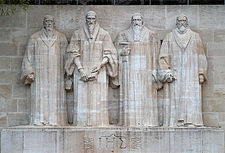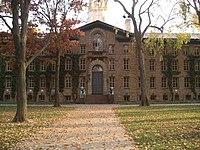
Princeton University is a private Ivy League research university in Princeton, New Jersey. Founded in 1746 in Elizabeth as the College of New Jersey, Princeton is the fourth-oldest institution of higher education in the United States and one of the nine colonial colleges chartered before the American Revolution. The institution moved to Newark in 1747 and then to its current Mercer County campus in Princeton nine years later. It officially became a university in 1896 and was subsequently renamed Princeton University.

John Witherspoon was a Scottish-American Presbyterian minister, educator, farmer, and a Founding Father of the United States. Witherspoon embraced the concepts of Scottish common sense realism, and while president of the College of New Jersey became an influential figure in the development of the United States' national character. Politically active, Witherspoon was a delegate from New Jersey to the Second Continental Congress and a signatory to the July 4, 1776, Declaration of Independence. He was the only active clergyman and the only college president to sign the Declaration. Later, he signed the Articles of Confederation and supported ratification of the Constitution of the United States.

The American Whig–Cliosophic Society, sometimes abbreviated as Whig-Clio, is a political, literary, and debating society at Princeton University and the oldest debate union in the United States. Its precursors, the American Whig Society and the Cliosophic Society, were founded at Princeton in 1769 and 1765.

The Princeton School of Public and International Affairs is a professional public policy school at Princeton University. The school provides an array of comprehensive coursework in the fields of international development, foreign policy, science and technology, and economics and finance through its undergraduate (AB) degrees, graduate Master of Public Affairs (MPA), Master of Public Policy (MPP), and PhD degrees.
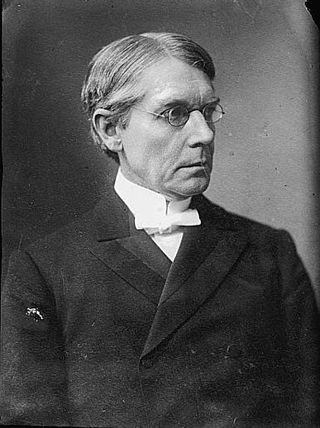
Francis Landey Patton was a Bermudan-American educator, Presbyterian minister, academic administrator, and theologian, and served as the twelfth president of Princeton University.

The Daily Princetonian, originally known as The Princetonian and nicknamed the 'Prince', is the independent daily student newspaper of Princeton University. The newspaper is owned by The Daily Princetonian Publishing Co. and boasts a circulation of 2,000 in print and around 30,000 daily online hits as of 2021. Managed by approximately 200 undergraduate students, the newspaper covers a range of sections, including news, sports, and opinions.
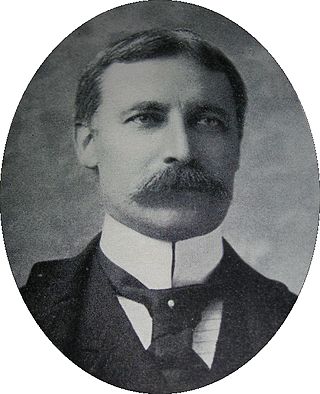
Moses Taylor Pyne, was an American financier and philanthropist, and one of Princeton University's greatest benefactors and its most influential trustee.

The Nassau Presbyterian Church is a historic congregation located at 61 Nassau Street in Princeton, New Jersey, United States. It has been the home of many important figures in the history of Presbyterianism in the United States as a result of its proximity to Princeton University and the Princeton Theological Seminary. The church operates the Princeton Cemetery and is a contributing property to the Princeton Historic District. The current pastor is the Reverend Dr. David A. Davis.

First College, the first of Princeton University's six residential colleges, was developed in the late 1950s when a group of students formed the Woodrow Wilson Lodge as an alternative to the eating clubs. The Woodrow Wilson Lodge members originally met and dined in Madison Hall, which is now part of John D. Rockefeller III College. Inspired by the ideas of Woodrow Wilson, president of Princeton from 1902–1910, the members advocated a more thorough integration of academic, social and residential life on campus.

Evelyn College for Women, often shortened to Evelyn College, was the coordinate women's college of Princeton University in Princeton, New Jersey between 1887 and 1897. It was the first women's college in the State of New Jersey.

Henry Burchard Fine was an American university dean and mathematician.

John Grier Hibben was a Presbyterian minister, a philosopher, and educator. He served as president of Princeton University from 1912–1932, succeeding Woodrow Wilson and implementing many of the reforms started by Wilson. His term as President began after the term of Acting Princeton President Stewart, who served for two years after Wilson's departure.

John Maclean Jr., D.D. was an American Presbyterian clergyman and educator who served as the tenth President of Princeton University, then known as the College of New Jersey. Maclean, the son of the first professor of chemistry at the College of New Jersey, grew up in Princeton, New Jersey. He attended the College and later Princeton Theological Seminary. At age 23, he became full professor of mathematics at the university. Six years later, he became university vice president. He was responsible for bringing a number of renown scholars and academics to the college. During this time, he also left mathematics and became professor of ancient languages. Maclean was one of the chief architects of the state's public education system. His plan for a state normal school, local boards of education and nonsectarian public schools was adopted by the state legislature. He became president of the College of New Jersey in 1854. He led the university through the 1855 burning of Nassau Hall and the American Civil War. After retiring from his post after 14 years in office, he wrote a two-volume history of the university. He served as the honorary president of the university's Alumni Association until his death.

The Princeton University Department of Psychology, located in Peretsman-Scully Hall, is an academic department of Princeton University in Princeton, New Jersey. For over a century, the department has been one of the most notable psychology departments in the country. It has been home to psychologists who have made significant scientific discoveries in psychology and neuroscience, such as adult neurogenesis in primate brains, the concept of the cognitive miser, bystander non-intervention, face-selective neurons in primate brains, feature integration theory, mental models theory, and prospect theory.
Princeton University School of Engineering and Applied Science is located in Princeton, New Jersey, United States. A school within Princeton University, which is one of the eight universities of the Ivy League, it provides undergraduate and graduate instruction in six departments: chemical and biological engineering, civil and environmental engineering, computer science, electrical engineering, mechanical and aerospace engineering, and operations research and financial engineering. It has more than 1,400 undergraduates, 620 graduate students and 147 faculty members in its six departments.
Coeducation at Princeton University refers to the transition of Princeton University from being a single-sex education university which only admitted males to being a mixed-sex education university.
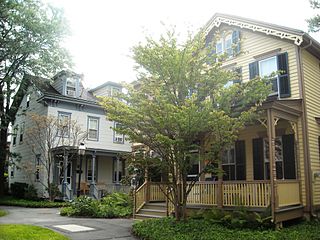
The Princeton Historic District is a 370-acre (150 ha) historic district located in Princeton, New Jersey that was listed on the U.S. National Register of Historic Places in 1975. It stretches from Marquand Park in the west to the Eating Clubs in the East, from the Princeton Cemetery in the north to the Graduate College in the south. The district encompasses the core parts of the campuses of the Princeton Theological Seminary and Princeton University. It also includes the business district centered on Nassau Street and many historic homes, both mansions in the western section and more humble dwellings in the Witherspoon/Jackson neighborhood. Notable churches within the district include Nassau Presbyterian Church, Trinity Episcopal, Nassau Christian Center, and the Princeton University Chapel. The district is home to seven of Princeton's nine, and New Jersey's fifty-eight, National Historic Landmarks, the largest concentration of such sites in the state.

FitzRandolph Gate is a wrought-iron structure that serves as the official entrance of Princeton University, standing in front of Nassau Hall on Nassau Street in Princeton, New Jersey. The gate was funded by a bequest of Augustus Van Wickle in honor of his great-grandfather, Nathaniel FitzRandolph, who had donated to the university the land on which Nassau Hall sits. The gate was completed in 1905 and was designed by McKim, Mead & White. The gate remained closed and locked apart from graduation and the P-rade until 1970, when that graduating class ensured that it would always remain open, "in a symbol of the University's openness to the local and worldwide community."
This bibliography of Woodrow Wilson is a list of published works about Woodrow Wilson, the 28th president of the United States. For a more comprehensive listing see Peter H. Buckingham, Woodrow Wilson: A bibliography of his times and presidency.
The Graduate School of Princeton University is the main graduate school of Princeton University. Founded in 1869, the school is responsible for all of Princeton's master's and doctoral degree programs in the humanities, social sciences, natural sciences, and engineering. The school offers Master of Arts (MA), Master of Science (MS), and Doctor of Philosophy (PhD) degrees in 42 disciplines. It also administers several pre-professional programs, including the Master in Finance (M.Fin.), Master of Science in engineering (M.S.E.), and Master of Engineering (M.Eng.), Master in Public Affairs (M.P.A.), Master in Public Policy (M.P.P.), and Master of Architecture (M.Arch.) degrees.
